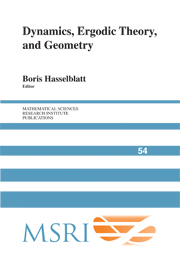Book contents
- Frontmatter
- Contents
- Foreword
- Quantitative symplectic geometry
- Local rigidity of group actions: past, present, future
- Le lemme d’Ornstein–Weiss d’après Gromov
- Entropy of holomorphic and rational maps: a survey
- Causes of stretching of Birkhoff sums and mixing in flows on surfaces
- Solenoid functions for hyperbolic sets on surfaces
- Random walks derived from billiards
- An aperiodic tiling using a dynamical system and Beatty sequences
- A Halmos–von Neumann theorem for model sets, and almost automorphicdynamical systems
- Problems in dynamical systems and related topics
Quantitative symplectic geometry
Published online by Cambridge University Press: 06 July 2010
- Frontmatter
- Contents
- Foreword
- Quantitative symplectic geometry
- Local rigidity of group actions: past, present, future
- Le lemme d’Ornstein–Weiss d’après Gromov
- Entropy of holomorphic and rational maps: a survey
- Causes of stretching of Birkhoff sums and mixing in flows on surfaces
- Solenoid functions for hyperbolic sets on surfaces
- Random walks derived from billiards
- An aperiodic tiling using a dynamical system and Beatty sequences
- A Halmos–von Neumann theorem for model sets, and almost automorphicdynamical systems
- Problems in dynamical systems and related topics
Summary
A symplectic manifold (M, ω) is a smooth manifold M endowed with a nondegenerate and closed 2-form ω. This is in sharp contrast to Riemannian manifolds, for which the Riemannian metric admits various curvature invariants. Symplectic manifolds do however admit many global numerical invariants, and prominent among them are the so-called symplectic capacities.
Symplectic capacities were introduced in 1990 by I. Ekeland and H. Hofer [18; 19] (although the first capacity was in fact constructed by M. Gromov [39]). Since then, lots of new capacities have been defined [16; 29; 31; 43; 48; 58; 59; 88; 97] and they were further studied in [1; 2; 8; 9; 25; 20; 27; 30; 34; 36; 37; 40; 41; 42; 45; 47; 49; 51; 55; 56; 57; 60; 61; 62; 63; 65; 71; 72; 73; 86; 87; 89; 90; 92; 95; 96]. Surveys on symplectic capacities are [44; 49; 54; 66; 95]. Different capacities are defined in different ways, and so relations between capacities often lead to surprising relations between different aspects of symplectic geometry and Hamiltonian dynamics. This is illustrated in Section 2, where we discuss some examples of symplectic capacities and describe a few consequences of their existence. In Section 3 we present an attempt to better understand the space of all symplectic capacities, and discuss some further general properties of symplectic capacities. In Section 4, we describe several new relations between certain symplectic capacities on ellipsoids and polydiscs. Throughout the discussion we mention many open problems.
As illustrated below, many of the quantitative aspects of symplectic geometry can be formulated in terms of symplectic capacities. Of course there are other numerical invariants of symplectic manifolds which could be included in a discussion of quantitative symplectic geometry, such as the invariants derived from Hofer’s bi-invariant metric on the group of Hamiltonian diffeomorphisms, [43; 79; 82], or Gromov–Witten invariants. Their relation to symplectic capacities is not well understood, and we will not discuss them here.
We start out with a brief description of some relations of symplectic geometry to neighboring fields.
Information
- Type
- Chapter
- Information
- Dynamics, Ergodic Theory and Geometry , pp. 1 - 44Publisher: Cambridge University PressPrint publication year: 2007
Accessibility standard: Unknown
Why this information is here
This section outlines the accessibility features of this content - including support for screen readers, full keyboard navigation and high-contrast display options. This may not be relevant for you.Accessibility Information
- 33
- Cited by
